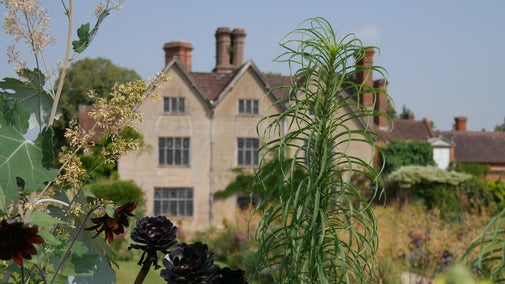
Discover more at Packwood House
Find out when Packwood House is open, how to get here, the things to see and do and more.

“A house to dream of; a garden to dream in.” So wrote a visitor to Packwood in the 1930s. Wander around the garden, and a bit further afield to find out how true that comment is. Discover herbaceous borders, wildflower meadows and a beautiful orchard. Don’t miss the bountiful kitchen garden and admire the magnificent yew trees.
Spring is a wonderful time at Packwood with plenty of interest throughout.
In March the gardens become awash with bright yellow daffodils and the best place to find them is along the roadside verges and a thick carpet lines the floor in the orchard.
The primrose bank will be in full bloom on the outer southern edge of the Kitchen Garden and the hellebores are showing their cream and purple faces in the double herbaceous borders. If you are lucky and the weather keeps mild you may see; echium pininana with its outrageously long ‘borage like’ blue and pink flower spike and melianthus major (honey bush) with its unusual brownish crimson to deep brick-red long flowers that last made their appearance in the garden at Packwood in 2013.
The main garden areas come alive in April when the tulips and wallflowers start to bloom. They add a welcome splash of colour to the gardens.
The sunken garden is also well worth a look for its succulents and the purple ‘Bowles’s Mauve’ perennial wallflowers all growing out of the crushed brick.
Further afield, under the oak trees, lurk delicate yellow dogs tooth violets with their sulphur-yellow nodding flowers and a few have found their way into some of the borders.

The gardens near the house were laid out in the 1630s by John Fetherstone, during the reign of Kings Charles I and II, hence its name – the Carolean Garden. The main features are:
Not strictly part of the Carolean Garden, the Sunken Garden, just across the south lawn, is a typical Arts and Crafts creation. Its building was interrupted by wartime austerity in 1941, but it has now been completed as a dry garden with exotic desert plants.

According to legend, the yew trees at Packwood represent the ‘Sermon on the Mount’ and are over 350 years old. Walk up the centre of the garden past the multitude of ‘figures’ to reach the grand finale of Packwood’s formal garden: the spiral mount and its imposing ‘master’ yew. Follow the spiral path up the mount to get the best view of Packwood's famous Yew Garden.
Just a short walk away, you will find:

There are lots of opportunities for family fun in the great outdoors at Packwood, from bird spotting to discovering wild animals. As you explore Packwood, pick up a seasonal spotter sheets to see how many signs of the season you can spot and tick them off along the way.

Find out when Packwood House is open, how to get here, the things to see and do and more.

Find out more about what it takes to care for and manage the varied garden areas at Packwood.

Find out more about Packwood’s mysterious Yew Garden, one of Britain’s major topiary gardens, and the work taking place to save it from decline.

Enjoy a range of walking routes on the estate surrounding Packwood, taking in fields, woodland and canals, and discover more about the flora and fauna you might see along the way.

Packwood House is the culmination of a single man's vision of Old English country hospitality. Step inside and discover a cow barn transformed into a Great Hall, a 1930s Long Gallery filled with 16th-century tapestries, and much more.

Delve into Packwood’s past and find out about how one man’s vision transformed a Georgian and Victorian style house into the perfect country house of Old England that we see today.

From winding paths through woodland to wide open spaces, Packwood is the perfect place for a family day out in the great outdoors.

Discover our gardeners’ top tips so you can make the most of your garden, plot or window box.

Find an inspiring garden in Warwickshire to explore, at beautiful places renowned for their formal planting, walled gardens and framed views round every corner.